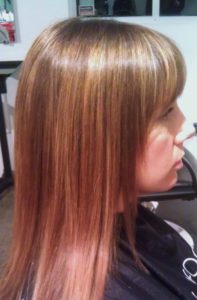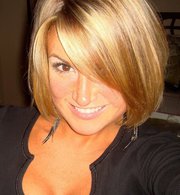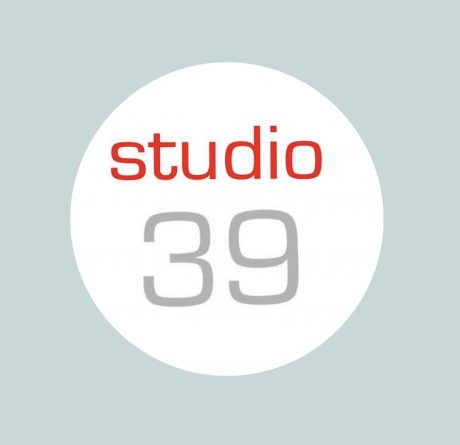Original post written by Gemy in June 2010
Balayage highlights have had a lot of buzz lately! We receive calls almost every day with inquiries about this technique, especially this time of year. So what is it? Well, this not a new technique. Salons in France have been using this technique for years. Traditional balayage highlights ( French word meaning “to sweep”) is when bleach or lightener is laid directly on the hair. Lightener is a professional word for bleach, w avoid using the word bleach in the salon. You bleach your clothes, not your hair…right?!
Besides, lightener has come a long way since the 50’s and 60’s when used bleach to get platinum hair. The lighteners we use in the salon for regular foil highlighting are clay based and loaded with special conditioners to help get blonde without damage. With that said, anytime you go lighter, you always need to add TLC to your home hair care afterwards. We will send you out of the salon with gorgeous highlights, but it won’t stay that way if you use Suave shampoo!
Different techniques.
 When salons of Paris originally started to balayage, they realized there were lots of factors in getting this look right. If you don’t know how to sweep the hair quickly and lay it on the hair properly you can have ugly bleed or “leopard” spots. We have fixed quite a few botch jobs for clients who have had some train-wreck -looking color from stylists who supposedly were “trained” on this. I have an entire blog written about why.
When salons of Paris originally started to balayage, they realized there were lots of factors in getting this look right. If you don’t know how to sweep the hair quickly and lay it on the hair properly you can have ugly bleed or “leopard” spots. We have fixed quite a few botch jobs for clients who have had some train-wreck -looking color from stylists who supposedly were “trained” on this. I have an entire blog written about why.
The product has to be the perfect consistency, so there can be no guesswork on mixing. Almost all the American made ” bleaches” I’ve worked with are not right for this technique because the swell. If you are going for a look that Europeans designed, then you need a European product made for this technique.
We use an Italian product that is hard to find. It took me 4 months to locate a supplier but it was worth the research! You have to be fast or there may be uneven processing. Some stylists I’ve seen lay cotton and cellophane in between rows of lightener. I get why but it makes it a bit more of a production.
Working quickly helps the hair to process evenly. Brush and a paddle are all I use and when a colorist does it well, it looks like an artisan doing ornamental plaster work. Which is why many stylists try this without having formal training on it. They don’t teach this in beauty school and if they do, they don’t expand much on it because it’s not on the State Board test. That is why it is very important that a colorist have specific training on this technique.
Balayage Highlights Remove Demarcation
When you have a stylist laying lightener directly on the hair without the safety of a foil- make sure they are confidant in what they are doing! The end result of a good balayage will be bright, sun kissed highlights that grow out naturally. There is no line of demarcation like with traditional foil highlights, it is more blurred and softer. Right now the Boho trend is huge, it has been for a while, and it’s not going anywhere. There is nothing soft or beachy looking about the line where striped highlights stop and you re-growth starts. That’s what we call demarcation line. Hair would definitely not look like that after a day at the beach. So balayage is economical in the fact that you don’t have to go to the salon every 4- 6 weeks. The best thing is, you don’t have to compromise being blonde, or having all over blonde. Rootier looks mean more blonde with less up keep.
 Foiling Balayage Highlights
Foiling Balayage Highlights
American balayage is a the same concept, but done inside the foil. This technique was designed by Beth Minardi, a famous New York colorist who is one of my preferred color mentors. For those clients who want this look, but have previously darker colored hair, or needs an all over base color as well, is a good candidate for this technique. Foil is metal and conducts heat, which then speeds up the processing time. For the person who has hair color on their hair, processing lightener without foil often does not blonde enough. We do every type of highlighting in the salon. A great colorist controls brown and blonde hair by assessing the hair to determine what it needs at that moment, and every technique has their place to achieve a clients desired look .
The are pictures here show the difference between traditional balayage highlights and foiling balayage highlights. Ask your stylist what’s right to get a look that’s tailored just for you and your hair color The photo left shows a blonde with a blended root area. Her is more diffused between the the roots to tips versus the brunette above where you can see more visible color placement. These clients had different color needs to had different techniques used to achive the look of balayage highlights.
Studio 39 Salon, in Kansas City, has expert balayage colorists. Call our salon today to book an appointment for your balayage color.
Ombre & Balayage 2010
Read the Post
Box Dye & Corrective Color
Read The Post
Good balayage questions:
If you book balayage with us, we guarantee your color. But we explain it and let you know it’s naturally warmer and soft at the root.
- How long has the stylist been doing balayage and where did she/he receive training?
- Do they use a special product designed for balayage? (Because they should.)
- What method do they use? (Freehand, paddle, etc.)
Number 3 is important. There are several types of balayage- most colorists just don’t know that! I do traditional French plus American Balayage. That’s a technique created by Beth Minardi. She’s a color pioneer and currently no-one in KC does it! If you do your research, you will end up with beautiful highlights that grow out well. If you don’t, you could end up with a corrective color costing double what you had planned. Maybe even have to wear a hat until you get it fixed.
That’s happened before.
Thanks for reading beauty friends!
Gemy 💎
